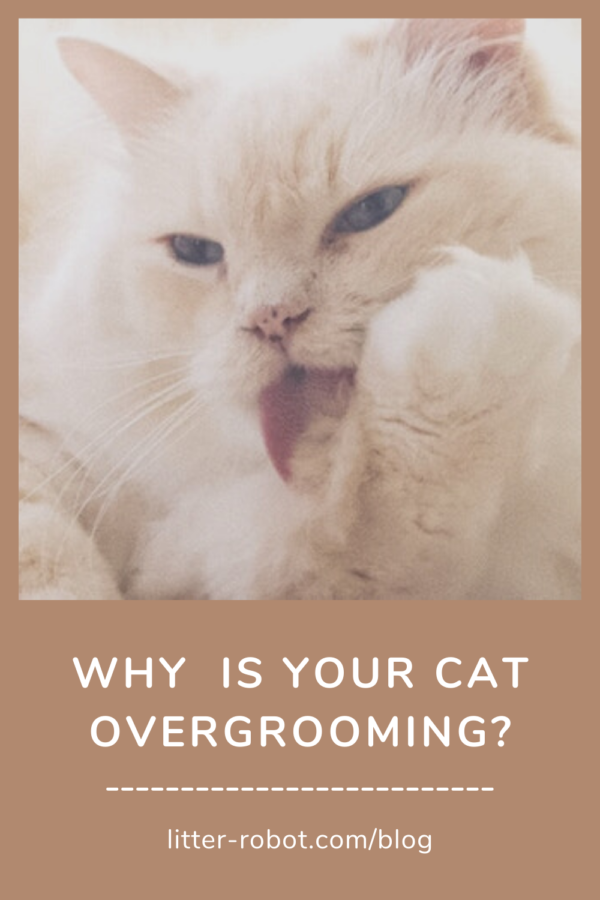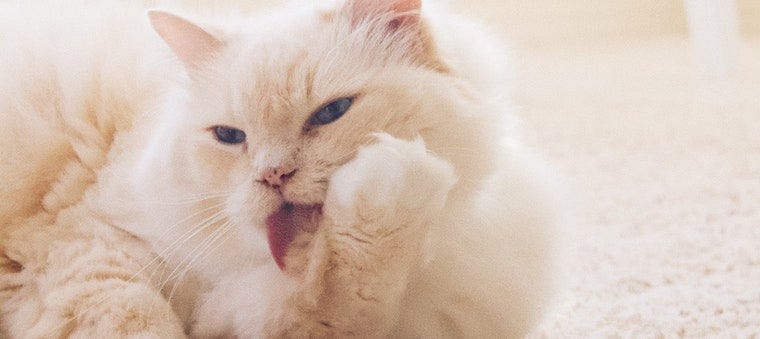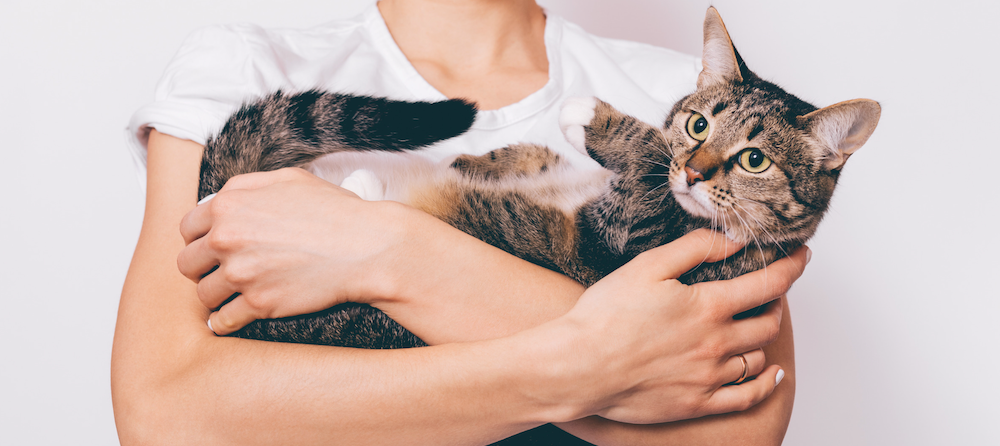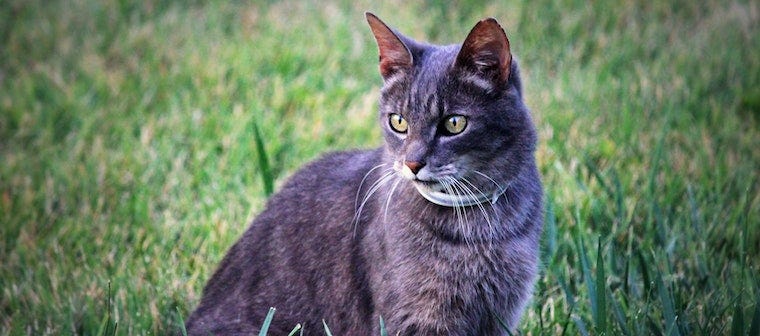Is your cat overgrooming? When felines begin to exhibit overgrooming behaviors, the exact reason can be hard to pinpoint because overgrooming is a symptom of a variety of conditions.
From behavioral issues to medical concerns, overgrooming is linked to many issues in cats. If you notice your cat is licking, nibbling, or biting themselves more often than usual, then it’s time to uncover the root cause of the problem.
While there is no quick fix for overgrooming, figuring out the reason why your cat is exhibiting that behavior in the first place means you can help your cat soothe themselves in other ways. Let’s take a closer look at overgrooming!
Why do cats lick themselves?
Cats groom themselves on a daily basis. Self-grooming is important as it helps cats remove dirt, loose hair, and parasites from their coats. However, this normal behavior can sometimes become excessive, turning your cat's grooming habits into something problematic.
When cats lick themselves, endorphins are released, which contribute to the soothing sensation that grooming creates for their bodies. These endorphins are neurotransmitters released by cats’ brains, and when released, these transmitters provide a comforting feeling.
If your cat has any behavioral issues stemming from stress or medical issues such as allergies, then they might resort to this behavior as a way to self-soothe.
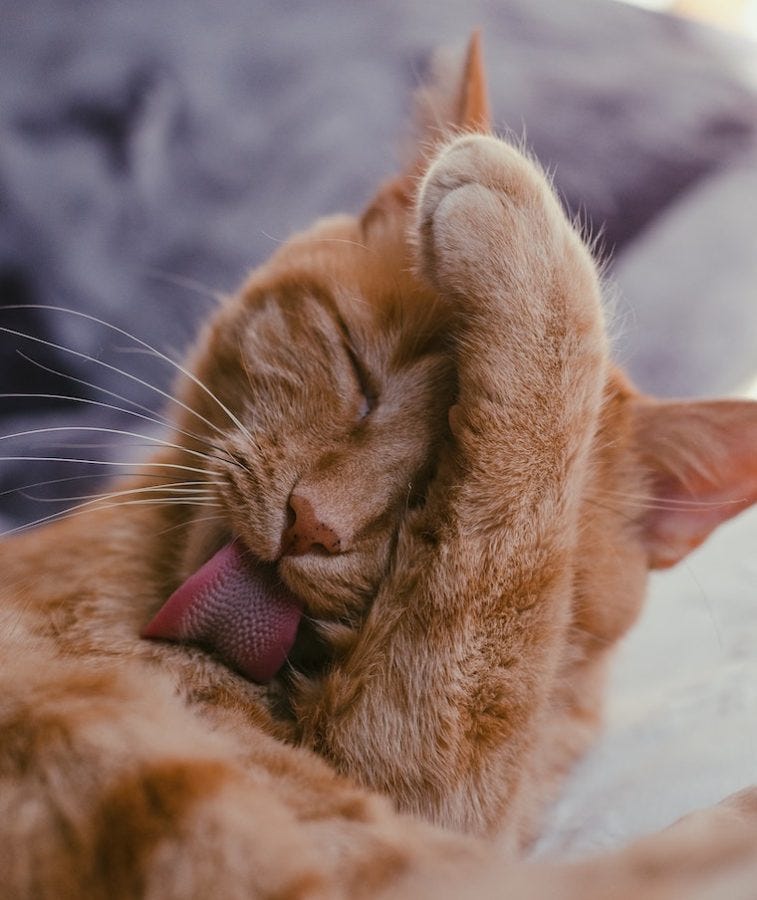
What causes excessive grooming in cats?
Cats overgroom for a variety of behavioral and medical reasons. The first thing you will want to check for is any underlying medical conditions, including:
- Fleas, mites, or other parasites
- Ringworm
- Hyperthyroidism
- Pain in a particular area of the body
- Allergies
- Food sensitivities
- Dandruff
Once these medical conditions have been ruled out, it is safe to assume that your cat overgrooming is the result of stress or behavioral conditions. For instance, psychogenic alopecia is a stress-related disorder that causes cats to start grooming themselves obsessively.
Psychogenic alopecia can be triggered by an array of stressors, including but not limited to the following:
- Moving to a new home
- Rearranging furniture
- Moving the litter box
- Introducing a new family member
- Lack of enrichment
- A chaotic household
- Changes to your work schedule
You will want to try to identify the stressor that is causing your cat to feel anxious because then you can either eliminate the stressor or help your cat adjust to the stressor in healthier ways. If you have made any changes to your cat’s environment or routine recently, some of those changes could be the reason behind your cat’s newfound self-soothing behavior.
What are signs of overgrooming in cats?
It is normal for cats to groom themselves for about 50% of the time that they are awake. After all, they are working hard to keep their coats clean and tidy. But if you notice that your cat exhibits any of the following signs of overgrooming, then it might be time to take a deeper look at your cat's grooming habits.
Hair loss
Feline hair loss is one of the most common side effects of overgrooming. The affected parts of the skin are typically around the belly and thighs of cats, and these areas will often exhibit redness and hair loss.
Skin irritation
Another common cause of overgrooming is skin irritation or itchy skin, which can lead to cats scratching themselves. Constant scratching and biting at the skin can further the irritation to the point of bleeding. Other signs of skin irritation include bumps or “pimples” on the skin; flaky or scaly fur; scabs or rashes on the skin or fur; swelling, thickening, or redness (inflammation) of the skin; and abnormal odor of the fur.
Hairballs
Feline hairballs are another giveaway. While occasional hairballs can be a normal sign of grooming, an increase in the number of hairballs can be an indication that overgrooming is at play.
Behavioral changes
Lastly, watch your cat's behavior throughout the day. Is the constant overgrooming disrupting daily activities? If your cat shows no interest in playing and only wants to groom themselves, it is a warning sign that shouldn’t be overlooked.
Stop cat overgrooming in 5 steps
Your cat might need your help in order to stop overgrooming themselves. It will take work on your part, but it can be done with time and patience. Here are a few steps that you can take to eliminate your cat’s behavior.
Rule out any medical conditions
First, start with your veterinarian. Schedule a vet appointment to make sure that there aren’t any underlying conditions causing your cat to overgroom. If you identify allergies, skin diseases, pests, or other medical conditions, work with your vet to find a suitable solution that will ease your cat out of their overgrooming habits.
Veterinarians often see cat overgrooming—and consequently hair loss—due to an underlying allergy to flea saliva. If a cat with fleas is also allergic to the pest’s saliva (on top of the discomfort fleas normally cause), the cat may overgroom to the point of hair loss. Use a fine-toothed comb to determine whether your cat has fleas, then talk to your vet about which medication you should use for treatment. Typically you will use a topical medicine like Revolution/Stronghold, Frontline Plus, or Advantage for fleas.
If your cat has achy joints or is injured, he may lick the site of the pain to ease discomfort. Keep in mind that arthritis in cats is chronically undertreated. If you suspect your cat is in pain, take them to the vet as soon as possible.
Identify stressors
Understanding the cause of your feline’s stress is the next step. Moving, redecorating, or introducing a new pet are all examples of scenarios that can make your cat feel stressed.
If you’ve recently moved, start introducing your cat to your new home by keeping them in one room at first. Add all of the resources they need to feel comfortable, like play toys as well as food, water, and a litter box.
Slowly expand their horizons and give them the option to explore other areas in your new place. Don’t pressure your cat to get comfortable with their new surroundings. They’ll come around when they are ready.
If you’re introducing a new family member or pet into the equation, do so slowly. Give your cat plenty of time to get acquainted with the new member of the family, and make sure you give them ways to escape the situation so that they can get away if they want to. Learn more about introducing your cat to a baby, to another cat, or to a dog.
If the absence of a person who is usually in your home is causing your cat to feel stressed, ask the person to leave behind a piece of their clothing. Give this to your cat as a stress reliever so that they still have the scent of the person they love even when that person is away from the home. Learn more about dealing with cat separation anxiety.
Incorporate play therapy into your cat’s schedule
Cats love attention, affection, and play time. So, be sure to set aside time throughout the day to give your cat a little extra play therapy. Make sure your cat has access to plenty of toys, scratching posts, and cozy places to sleep. When possible, interact with your cats and play with them using engaging toys like laser pointers or mice on strings.
Create a consistent routine
Cats thrive in environments where there is a lot of stability and consistency. They need areas where they can feel safe, too.
Cats should also have an area to eat and drink without worrying that they’ll be interrupted or bothered. When your cats know that their home is a secure and stable area, they will experience little to no stress, which will reduce their need to self-soothe via overgrooming.
Seek help from a behaviorist
If your cat has been overgrooming themselves for a long time, it is likely going to be a habit that is hard to break. Just like people form habits, cats develop habitual patterns of behavior as well.
The habit of overgrooming, as well as the feelings that the endorphins create, can cause your kitty to keep grooming themselves even if they are no longer stressed. This is because overgrooming has become a habit, and habits can be really hard to break.
A qualified behaviorist can help you modify your cat’s behaviors. It’s important to remember that you should not punish your cat for this behavior because that will only lead to more stress and a fractured relationship between the two of you.
Instead, do your best to encourage them, play with them, and maintain a calm environment for them while you work with a professional to kick the habit.
Be patient while you search for the cause of cat overgrooming
When was the last time your cat took a trip to the vet? If it has been a little while or you’ve noticed that your cat is exhibiting new symptoms such as overgrooming, then calling the vet and scheduling an appointment is worthwhile. That way, the veterinarian can rule out any and all underlying medical conditions.
After you’ve taken your cat to the veterinarian, consider what the possible stressors could be in your home so that you can find the underlying reason for the behavior of overgrooming. But remember to be patient. The overgrooming issue will not fix itself overnight.
It will take time for your cat to stop this behavior, just like it will take time for their hair to regrow or their skin to stop itching. Find ways to keep your cat happy and engaged at home as a way of distracting them from their tendency to overgroom themselves.
Provide new places for them to take a cat nap, such as a fun piece of cat furniture, or purchase new toys for them to play with and seek entertainment from throughout the day. No matter what you do, remember that patience and love will help them get over their habit of overgrooming as you work together to stop this behavior!
Cover photo by Joyful on Unsplash
